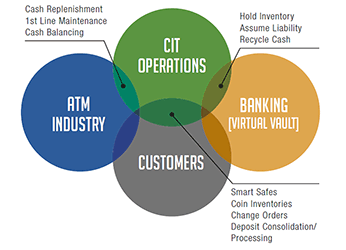
Understanding the Relationships in the Cash Industry

Stop for a minute and think about the flow of cash in the American economy. You almost certainly have some in your pocket or purse right now, and at some point in the day, or the near future you will use it to buy something. Even if you rely mainly on plastic, you will sometimes tap an ATM for cash. Billions upon billions of cash dollars circulate every single day. Most importantly, you, and all parties concerned can easily access just the right amount of cash for their needs.
This miraculous flow of cash does not happen by accident. The Cash-in-Transit (CIT) system—a.k.a. the cash management industry—has evolved to manage cash efficiently and securely. This huge system is ubiquitous, yet many people have never heard of anything beyond “armored cars.” The system actually includes a large assortment of cash management businesses, some of them specialized and others offering a fully integrated package of services that help to keep commercial and retail markets liquid.
The CIT system serves banks, including the Federal Reserve, by providing the transportation, storage, processing, accounting, and other services that financial institutions need to ensure the right amounts of cash get to where they are needed. With the extensive geographic dispersion of branch banks and ATMs, it is no longer cost effective for each and every bank to provide all the cash management services it needs. Today, third party businesses in the cash management system can support multiple banks, including providing a level of risk management the industry demands.
Core Components of the CIT System
The CIT system still relies on armored cars for transporting cash. But beyond this time-honored function, it now also provides ATM services, and “virtual vaults” that can provide banking functions such as deposit processing and check imaging. Basically, the businesses in this system can replicate the functions of an internal bank vault.

The ATM network is an especially important part of the CIT system. These machines require frequent servicing for cash replenishment, deposit collections, and reconciliation. However, many of them are outdoors, making them a prime target for robbery. In these circumstances, banks outsource the cash management services the networks require.
“Virtual vaults” offer banking customers the security of hardened facilities without the expense of building them in every location they are needed. A virtual vault can be built with the same physical protections and function with the appropriate cash management operational controls, and penetration resistance. They are used to store cash for multiple customers, with rigorous internal accounting and physical inventory controls to ensure the integrity of individual accounts.
Users of cash, like retailers, may be unaware that the CIT system businesses that serve them are not literally their bank. The cash management businesses can provide the very same services and security they would expect from the bank. Thus, the CIT business provides cash to the retailer, securely stores short-term deposits, maintains inventories, and processes cash and coin as needed.
Risk Management in the CIT System
Banks have transferred very important functions to CIT businesses. In the process, they have also transferred the corresponding risk: cash is valuable everywhere, easy to conceal, and easy to distribute.
There are three primary arenas in which cash management businesses manage risk: internal controls, insurance, and 3rd party audits.
Internal Controls
Simply put, cash management businesses have to identify where risks exist and install controls to mitigate them, just like any other business. In the CIT system, the intersections between the banks, their cash-using customers or ATMs, and the carriers are the points where risk is greatest for losses. These can include losses to criminal activity like robbery, with its threat of violence, but can also be in-house fraud and theft, as well as ordinary mismanagement.
Insurance
The insurance business is in place to provide a safety net when losses occur and help mitigate varying risks. In the CIT system, the potential losses can be very large, so insurance companies use strict underwriting criteria that incorporate cash handling industry best practices. Cash management businesses have a strong incentive to meet the underwriting criteria in order to obtain insurance and keep premiums manageable.
Third Party Auditing Firms
A second partner in CIT risk management is the third party auditing firms that specialize in cash management. These external firms are independent and have broad enough experience to be able to help cash management businesses identify risks and find ways to control them.
Every party in the CIT system has an incentive to minimize the risk associated with cash management. This joint incentive helps promote transparent relationships that are essential in an industry where so much value is so widely distributed. The cash management industry depends on these relationships to keep the cash flowing.
Learn more about the risks and relationships in the cash management industry by downloading our latest whitepaper: “Security and Collaboration in the Cash Management Industry.”
ABOUT THE AUTHOR